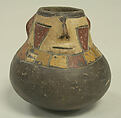Miniature Effigy Vessel
Not on view
This Paracas miniature effigy vessel has a stylized human head with bulbous lower body. Three horizontal incisions indicate closed eyes and mouth. A thin nose and subtly rounded red triangles on either side represent ears. Post-fire resin paint highlights facial features on a cream background. Black paint highlights the bridge of the nose and indentations for nostrils. Extending below each eye is a deep red triangle. Closed eyes and red triangles below suggest the individual depicted is deceased. The red triangle may represent cinnabar, a mineral bright red in color that is often applied to funerary masks and artifacts found in the graves of high-status individuals in the Andes. Below the head is a row of incised geometric shapes alternating in red, yellow, and green colors suggestive of a decorative collar. In ancient cultures, deceased individuals were often interred wearing fine jewelry and clothing.
The production of such a vibrant spectrum of colors on this miniature effigy vessel was unprecedented at the time and resulted from the innovative Paracas technique of applying pigmented resin after the ceramics had been fired. Colors were made from iron oxides and copper minerals and clays that were mixed with a resin to bind it to the surface of the ceramic. This paint was then applied after the ceramics had been fired. Many of the pigments necessary to create these resin paints were not locally available in the region and Paracas craftsmen relied on trade networks to attain some of these colors.
This exceptionally small effigy ceramic barely reaches three inches in height. A comparison to other miniature Paracas vessels highlights another vessel in the Metropolitan’s collection, Bottle with Incised Designs (MMA 64.228.91). Its small size and limited volume makes it quite impractical to suggest it was used in everyday life. The vessel’s shape and depicted subject matter suggest that it is had entirely a ritual purpose. This miniature vessel’s globular shape is reminiscent of a mummy bundle.
The Paracas culture was named for the Paracas peninsula along the south coast of Peru where Paracas material culture was initially found in the early 20th century. One of the earliest cultural traditions identified on the south coast of Peru from 700 B.C. – A.D. 1, it is best known for its funerary traditions. Paracas people interred their dead in mummy bundles. The dead were wrapped in layers of cloth, finely made textiles, and clothing. Included in the bundles were funerary offerings, and it is likely this miniature effigy vessel was discovered in a Paracas funerary bundle.
Lolly Burrows, M.A. Candidate Bard Graduate Center, 2017
Related Objects
64.228.91 Bottle with Incised Designs
1976.287.29 Bottle
63.232.10 Bottle, Face
63.232.80 Bridge and Spout Bottle
62.266.62 Bowl with Face
1974.124 Bowl
References and Further Reading
Daggett, Richard. “The Paracas Mummy Bundles of the Great Necropolis of Wari Kayan: A History.” Andean Past, 4 (1994): 53-75.
DeLeonardis, Lisa. “Encoded Process, Embodied Meaning in Paracas Post-Fired Painted Ceramics.” In Making Value, Making Meaning: Techné in the Pre-Columbian World , edited by Cathy Costin, 129-166. Washington D.C.: Dumbarton Oaks Research Library and Collections.
Kroeber, A. L. Paracas Cavernas and Chavín. New York: Kraus Reprint, 1965.
Kubler, George. The Art and Architecture of Ancient America: The Mexican, Maya, and Andean Peoples. New Haven, Conn.: Yale University Press, 1993.
Peters, Ann H. “The Cemetery of Paracas Necropolis: Mortuary Practice and Social Network.” In Tres Ensayos Sobre Paracas Necrópolis: Historia de la investigación, las tecnologías textiles y las prácticas mortuorias. Vol. 2 of Art Encuentro, eds Carole Sinclaire Aguirre, Andrea Torres Vergara, and José Berenguer Rodríguez, 43-66. Santiago: Museo Chileno de Arte Precolombino, 2016.
Proulx, Donald A. “Paracas and Nasca: Regional Cultures on the South Coast of Peru.” In Handbook of South American Archaeology, edited by Helaine Silverman and William Isbell, 563-585. New York: Springer, 2008.
Sawyer, Alan R. Ancient Peruvian Ceramics: The Nathan Cummings Collection. New York: The Metropolitan Museum of Art; distributed by New York Graphic Society, Greenwich, Conn, 1966.
Silverman, Helaine. “The Paracas Problem: Archaeological Perspectives.” In Paracas Art and Architecture: Object and Context in South Coastal Peru, edited by Anne Paul, 349-415. Des Moines: University of Iowa Press, 1991.
Silverman, Helaine. “The Formative Period on the South Coast of Peru: A Critical Review.” Journal of World Prehistory 10, no. 2 (1996): 95-146.
Stone, Rebecca. Art of the Andes: From Chavín to Inca. 3rd ed. Thames & Hudson World of Art. London: Thames & Hudson, 2012.
Due to rights restrictions, this image cannot be enlarged, viewed at full screen, or downloaded.

